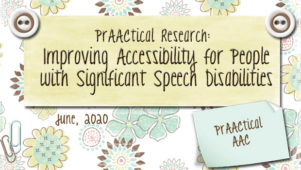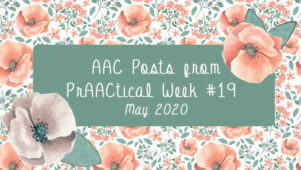Research Tuesday: Comparing Picture Exchange and SGDs

Picture exchange is powerful strategy for building symbolic communication in individuals with significant communication difficulties. We’ve posted about implementation of PECS a few times, and included references to research supporting its efficacy in some additional posts. Today, we look at a sequence of three single subject design experimental studies by Dr. Jeff Sigafoos and other researchers that looked at how the use of picture exchange and AAC devices (SGD condition) impacted social interaction.
In the initial study, the team taught requesting skills either with picture exchange or AAC devices and then looked to see if there were any changes in social interaction. They hypothesized that the physical act of picking up a symbol and giving it to someone, as with the picture exchange condition, would make the learner less likely to turn away from his communication partner. So, in addition to measuring how well the participant learned to make requests, they also wanted to see if the exchange feature in the picture exchange condition would result in increased attention to the communication partner. The participant learned both systems quickly, but there was no impact on social interaction (as measured by these researchers).
In the second study, the participant had access to both modes of communication, picture exchange and SGD, and was free to choose either one to make a request. Again, neither condition significantly influenced the learner’s social interaction with the communication partner.
For Study 3, the participant used only picture exchange, but the intervention focused on systematically increasing the distance between the learner and the communication partner in order to elicit social interaction. The added distance was the only condition that resulted in positive social interaction outcomes. Thus, while both the picture exchange and SGD options were effective in building requesting skills, these tools in and of themselves may not be sufficient to promote social interaction. As experienced AAC interventionists well know, the real gains come from well-designed and consistently implemented intervention, not just in having access to specific tools.
:::::::::::::::::::::::::::::::::::::::::::::::::::::::::::::::::::::::::::::::::::::::
Sigafoos, J., Green, V., Payne, D., Son, S., O’Reilly, M., & Lancioni, G. (2009). A comparison of picture exchange and speech-generating devices: Acquisition, preference, and effects on social interaction. Augmentative and Alternative Communication, 25(2), 99–109.
Link to the Online Article – http://informahealthcare.com/doi/pdf/10.1080/07434610902739959 [paid access if not an ISAAC journal subscriber]
Filed under: PrAACtical Thinking
Tagged With: Jeff Sigafoos, picture exchange, research, Research Tuesday, SGD
This post was written by Carole Zangari




